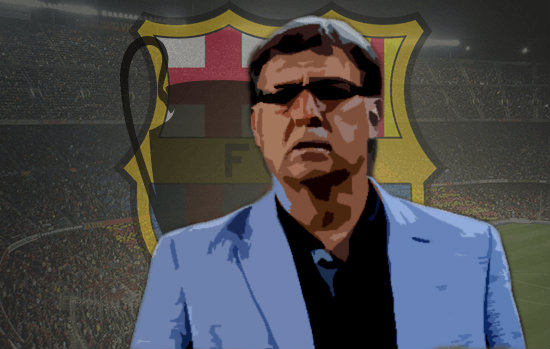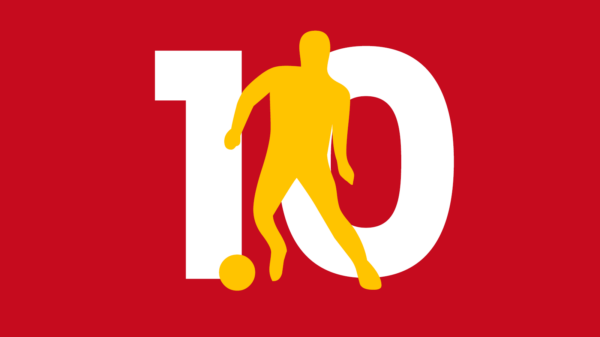In anticipation of the massive Champions League ties in the Quarter-Final stage, we’ve done something special for our build-up. Eight teams, eight experts, each giving us their insight into their team’s chances, tactical set ups and bold predictions.
Euler is the expert for this piece which focuses on Barcelona and their Champions League campaign. You can find him on Twitter @euleri. He specialises in Tactical articles and his work can be found regularly on the excellent Barcelona Football Blog.

Firstly, what are your thoughts on Barcelona’s Champions League campaign so far?
Barça’s CL campaign this year has been an experiment of sorts with Tata Martino exploring how to balance the significant continuing strengths of the team while minimizing their growing vulnerabilities. The team’s performance this year in the Champions League has been a clear improvement from how they played in the competition last season (particularly after the season was thrown into complete disarray by Tito Vilanova’s very sad recurrence of cancer).
Broadly the team has improved versus top competition this season, both in the Champions League and in the La Liga. And I think much of that has to do with Martino coming to understand and admit to what the team’s weaknesses are rather than trying to continue as if the team were still the same as it was back at its high point.
Perhaps key match for Barça in the Champions League this season was the first match versus Ajax in the group stage of the competition. By key here I mean the most telling – I think that match marked a kind of turning point in Martino’s early thinking. The first match vs Ajax was noteworthy as Xavi didn’t play. Instead Martino looked to rotate his midfield. Over the past several years Xavi has rarely been rested in any Champions League match so resting him was an important change. Barça went on to win that match 4-0. But what was so striking about the game was how it was played. The match was extremely open with Barça often looking unstable even while leading by multiple goals.
At the time Martino was still looking to implement a style of play incorporating more verticality. But even when leading by multiple goals Barça struggled to retain match control in their usual fashion. This has proven a major problem for this team. Without match control Barça’s defensive limitations come to the fore. Without control the limitations in the backline and the team’s reduced capacity to press, particularly in the midfield zone, are exposed. In that first match vs Ajax leading by 3 goals Martino felt the need to bring on Xavi for stability. Since then Martino has rotated players and experimented with different styles of play – but he has been extremely reticent to rest Xavi. While Xavi is older now and suffers from chronic Achilles tendinits, he remains fundamental with respect to control and it’s been difficult for three managers now to change the systems in ways that allow Barcelona to function without Xavi on the pitch.
MORE READING | Barcelona 1-1 Atletico Madrid: Tactical Analysis (First Leg)
Expert Interview: Who could be Atletico’s key player besides Diego Costa in the Champions League?
Atletico Madrid 1-0 Barcelona: Tactical Analysis (Second Leg)
This balance-control vs verticality-has been one of the major stories of Martino’s first season. How to balance diversification of a template by adding verticality to a team whose goal prevention is extremely dependent on match control with the ball. And that’s played out most directly in the Champions League.
Ultimately, Martino reduced the additional verticality he was looking to play with early on in order to augment match control, particularly in the Champions League and in matches versus top competition. Without control there wasn’t enough stability to minimize the deficits in the backline and the pressing game – these were the problems that were exposed in the Champions League for Barca last year.
This came to the fore in the tie versus Manchester City where Martino elected to utilize four midfielders and remove a forward. This was an acknowledgement that the team’s positional play and ability to enact control in the midfield zone was now dependent on explicit numerical superiority – a major break from its abilities in the recent past. But acknowledging this limitation has been important to Barça’s success in the CL and versus top sides this season. It also shows tremendous pragmatism by Martino as it wasn’t how he set out to play when he initially took over.
With only two senior centre-backs in the squad, could the rest of the Champions League campaign be defined by Pique’s injury?
Pique’s injury is very problematic for Barça – both in the Champions League and in the league. No other player has his profile, particularly his comparative ability in the air. In addition, just by sheer numbers the injury is very difficult. Puyol is trying once more to rush back from injury but he hasn’t played in quite some time. Another injury to a CB will likely mean Adriano will be forced into makeshift CB duty. The loss of quality will be felt – Pique while perhaps not fully back to his top level of play has had a strong season overall – much improved from his form from last year.
Fortunately, the latest reports are that Pique’s hip fracture may not be as bad as it initially looked and that he may return within two weeks rather than four. That helps with the league trophy race but still creates problems in this next Champions League match vs Atlético Madrid.
Marc Bartra came on for Pique in the first leg and played extremely well. Barça will need a similar performance this match in order to advance. Bartra has overall played well this season – particularly in 1 v 1 situations in space. But the areas where his game is less developed – aerially and in terms of strength- were precisely the ones that Pique provided to this Barça side. The loss of Diego Costa’s presence will reduce the risks of using Bartra but it’s still a major challenge for a young and still inexperienced player.
Atletico Madrid set up strongly as Simeone has embedded a clear tactical identity onto the club. What do Barcelona need to do to break them down at the Calderon?
For me, Atleti execute what their template more consistently and at a higher level than perhaps any other side in Europe. That’s not saying they are the “best” side – but in terms of pure system execution they are remarkable. Almost machine like in the precision of their shape, pressure, and coordination across zones.
We often consider tactical dimensions of pressing and staying compact along the vertical axis of the pitch. What Simeone has done so remarkably-perhaps his most interesting innovation- is the way Atleti press horizontally and stay compact through dynamic coordination of their block and shape along the horizontal axis of the pitch.
Atleti play very narrow looking to overload the central zone of midfield. Most sides that do this suffer from conceding space wide along the flanks. But Atleti rarely suffer from the space they initially concede. This is due to how dynamically they press horizontally. Their ability to pressure from the narrow initial shape when the ball is played to either flank is extremely impressive. It’s also a particular testament to how hard their players will work for Simeone-the strikers in particular.
Despite the movement and speed required to close down the ball wide, they still retain highly efficient shapes. For example, when you watch them play notice how often they’re able to create defensive triangles wide. This allows them to create cover for two advanced defenders while only using three players. The player at the deep apex of the triangle (usually the full-back) is often able to provide cover for both defenders at the base of the triangle. Just wonderful stuff.
MORE READING | Atletico Madrid 0-0 Barcelona: Tactical Analysis (La Liga)
Barça have struggled to break down due to this balance. Atleti overload the central zones while still compressing space wide. That’s their game. Simeone isn’t simply overloading the middle as a reactionary defensive tactics. He wants to overload the middle numerically to goad you into using the open zones wide where the two attacking full-backs are generally stationed. But once the ball is distributed wide his team closes down very rapidly and utilized the touchline as an “extra defender” very efficiently. They make the pitch very small in that zone and are very effective at dispossessing the ball and starting their positional attack in turn.
I think the way to counteract this strategy is to try to break their shape in the middle by overloading that zone through diagonals runs from the full-backs. Those runs should be directed at Atleti’s two deep midfielders. Force those deeper midfielders to provide cover/support for “extra men” in midfield. At the same time, keep the two lateral forwards wide to create 1 v 1’s with the full-backs. Drop them deep into the open space & then swing the ball wide to allow them to run at the full-backs without the extra cover from the Atleti midfielders. This can be augmented by having the striker draw wide as well to create 2 v 1’s.
Under Tata Martino, Barcelona have adopted a more direct game at times, especially in the Champions League. Does this worry Barca fans in terms of their progress in the competition?
Martino experimented with greater verticality and direct play earlier in the season e.g. first Champions League match vs Ajax. But since then he’s adjusted and understood the vulnerabilities the team has when they lose match control. Barça do play more directly but it’s less than earlier in the season when Martino was experimenting initially.
I think the major change Martino has made that he’s retained more consistently is in the positioning of the forward line. Rather than having Messi drop deep to support Barca’s positional play in midfield he’s instructed him to play higher to act as a vertical outlet – either stationing himself on the shoulder of the CBs or in finding space between the lines. Martino’s done something similar with the other forwards. Instructed them to stay higher rather than drop to support midfield. He’s also changed the dynamics of play and this is were the verticality remains most consistent. Barça will break faster when Messi and Iniesta initiate play (Iniesta has augmented his role in the transition phase very effectively this season). Both players can do so comparatively safely as both lose the ball so infrequently even at speed.
But in order to keep the forwards playing higher while still enacting match control through the ball Martino has been forced to play four midfielders and only two forwards. This is the concession he felt he had to make.
He’s consistently used Messi and Neymar upfront along with the four midfielders in nearly all of the “big” matches Barça have played. In the first league match vs Real Madrid he used Cesc as a false 9 and Messi on the right (though that was influenced by Messi’s injury problems & fitness).
But since the Champions League tie with Manchester City he’s implemented a set up with Messi as the false 9, Neymar on the right and Iniesta as a hybrid left winger/midfielder along with Xavi, Busquets and Cesc. This configuration maximizes match control but also diminishes the vertical outlets Barça has available to it (and particularly places enormous burdens on Messi to create penetration and score); but it has obtained results.
With the reconfiguration of the team’s template for the Manchester City tie, a number of observers applauded this move. Martino was purportedly re-implementing the “true” Barça model. But it was anything but. This Barça’s project at its best was based on a system of positional play that enacted a breathtaking level of precision in midfield. This allowed the side to create a level of match control far exceeding its numerical presence in the midfield zone. It allowed the team to dominate teams that were far more athletic and physical.
Much of this was based on the overwhelming impact Xavi had on matches – especially on the “biggest” matches. In addition, Xavi along with Busquets were perhaps key players in Barca’s pressing game. But with the chronic Achilles tendinitis Xavi has been significantly affected by since the middle of the 11-12 season, Barça’s positional play and pressing have diminished.
Xavi’s physical limitations aren’t the entire story of course. Barca’s pressing game has also diminished due to Messi’s reduced work rate and the opposition altering the way it attacks Barça’s left channel. But Xavi was the foundation of that team and system and his influence was staggering. His positional play and pressing were the crystallization of what that side was. The influence is what allowed Barça to enact match control at that level.
Barça’s initial response to Xavi’s diminished play was to have Messi drop into midfield more and more to support the positional play. But that was very problematic as it meant Barça had no true vertical outlet. In turn the opposition could press out of a mid-block and “squeeze” Barça back into midfield. These limitations were very evident and problematic in the CL last season.
Martino has tried to work between these two poles – how does he enhance goal prevention through match control while still enacting enough vertical outlets to create the penetration required for Barcelona to stretch the opposition block, open space and ultimately promote goal scoring. This has been the central strategic issue Barça have tried to grapple with this entire season.
What would your starting XI for the second leg against Atletico Madrid be?
Barça need to score to advance after Alteti gained the advantage of the away goal in the 1-1 first leg at Camp Nou. But Barça also can’t afford to concede first away at the Calderon. Conceding will allow Atleti to focus on retaining shape & pressing. They will be extremely difficult to break down.
This second leg is very different due to Diego Costa and potentially Arda Turan’s absences. Atelti are extremely dependent on Costa in the transition phase – there may be no player a team is more dependent on for a function than Atleti is on Costa in transition. When he left the first leg of the tie Atleti’s ability to counter diminished significantly. This will be even more amplified if Turan is unable to play.
Given this, I think Barça should take the risk of playing three forwards with Alexis on the right and Neymar returning to the left, where he’s more dangerous as a scorer. Barça should be able to enact enough control with three midfielders given Atleti’s diminished ability in the transition phase due to injury. Cesc Fabregas’s recent run of poor form also plays into this decision. The rest of the line up picks itself. Pinto/ Alves/ Bartra /Mascherano /Alba/ Busquets/Xavi /Iniesta/Sanchez /Messi/Neymar.
All this said-I expect Tata to continue to elect for enhanced control and play Cesc rather than the third forward. I think he’ll stay with the changes and the template that have worked for him, though he could rearrange the shape e.g. play Cesc as a false 9 rather than in midfield as has been rumored.
We attempt to track the progress of the best young players as much as time allows under our #TalentRadar and Scout Report features. Which youngster coming through from PSG are you most excited about?
There’s a tremendous wealth of talent in the youth system for Barça right now, particularly at the wide forward and central attacking midfield positions. A few players have really rapidly accelerated their development this season. Adama Traoré is a phenomenal talent. His combination of technical skill and physical explosiveness is something to watch. Though technically registered with Barcelona’s Juvenil A (u19) side he’s played most of the season with Barcelona’s B team in the 2nd division in Spain this year though he was only 17 at the start of the season. He’s had a great season and has continued to improve rapidly. He’s commanded double marking wide for much of the season. By profile he’s been more of a wide creator in the past but it’s been a real positive to see his finishing developing this season.
Munir El Haddadi, one of the most promising players at La Masia coming into this season, has also continued his rapid ascent. He too while registered to the Juvenil A side is now playing with the B team. He’s the current top scorer in the UEFA u19 tournament. Lee Seung Woo is another enormous talent. He’s unfortunately been prohibited from playing in league competition due to prior FIFA regulatory rulings but has played in international youth tournaments for Barcelona and been brilliant.
While those three are enormously gifted, it’s a disservice in many ways to leave so many other players out. On the B team Denis Suarez (who you’ve profiled prior while at Manchester City) has been terrific in his first season with Barcelona as has Sergi Samper. Alejandro Grimaldo returning from an ACL injury last year remains a very gifted left-full back. All three of those players have a real chance to play for the Barcelona 1st team. Edgar Ie a centre-back/right full-back is a lesser known player but promising, though often injured.
The Juvenil A team is simply filled with talent-more so than even the B team-and have had an outstanding season. Wilfred Kaptoum is a player I particularly like on that squad.
Finally, if you were to make a prediction for the tie, who do you see going through? Any particular scoreline for the second leg?
This will be an extremely close match. The two teams have played to one draw after another this season. Either could advance. I do think Atleti’s injuries will be particularly difficult for them to absorb if Costa and possibly Turan can’t play. Both are so integral to their positional attack and defense. But playing at home Atleti will be extremely difficult to score against. It’s going to be a fascinating battle from two teams that play such different systems. And I hope that’s what we’ll take away from this match – how wonderful the game is and how it can be played at such a high level in such divergent ways.
What do you think? What are your thoughts on Barcelona and their tactical set-up this season? Is it enough for them to go all the way in the Champions League?
For the rest of our interviews from this series and all our other interviews, head this way.

























































